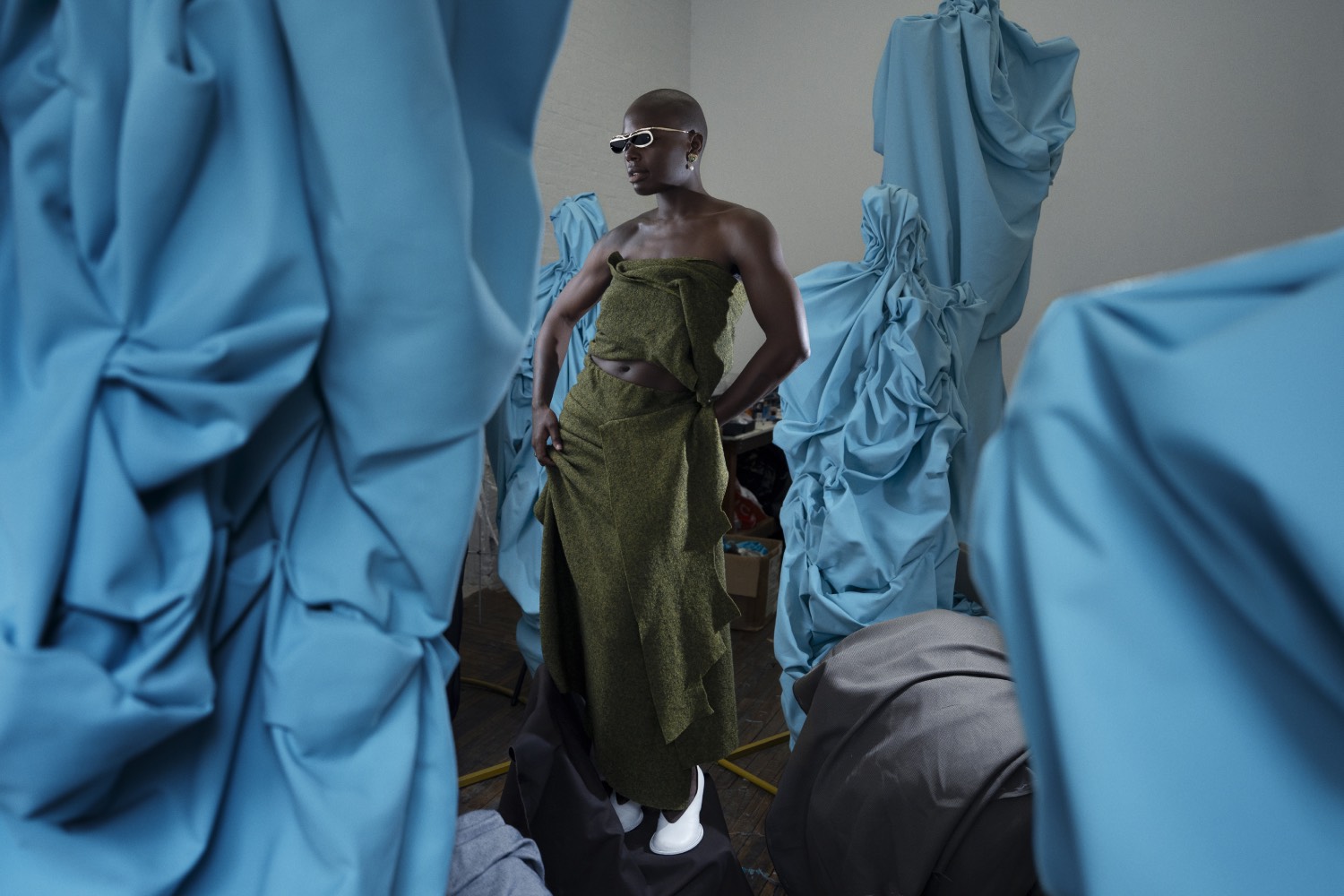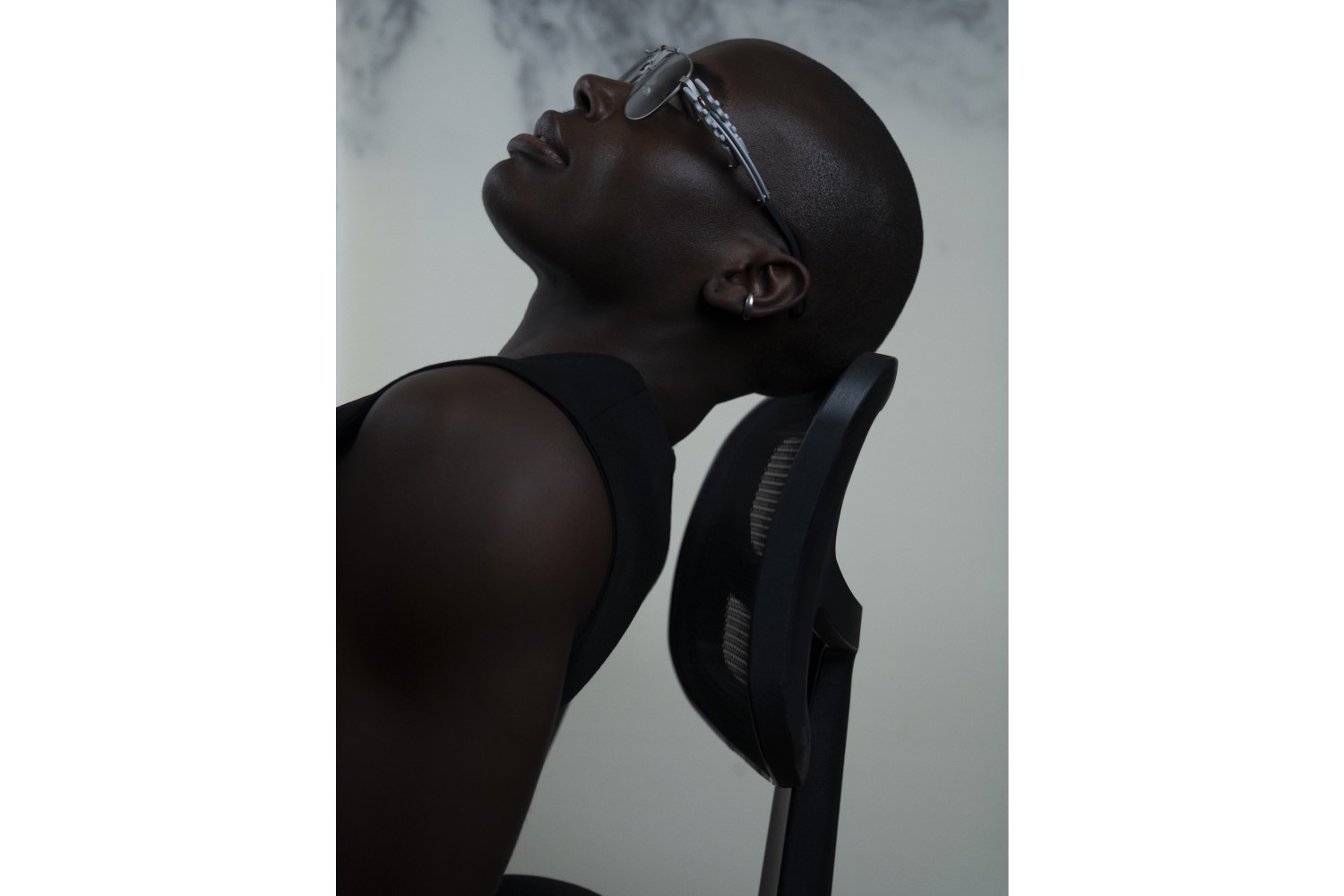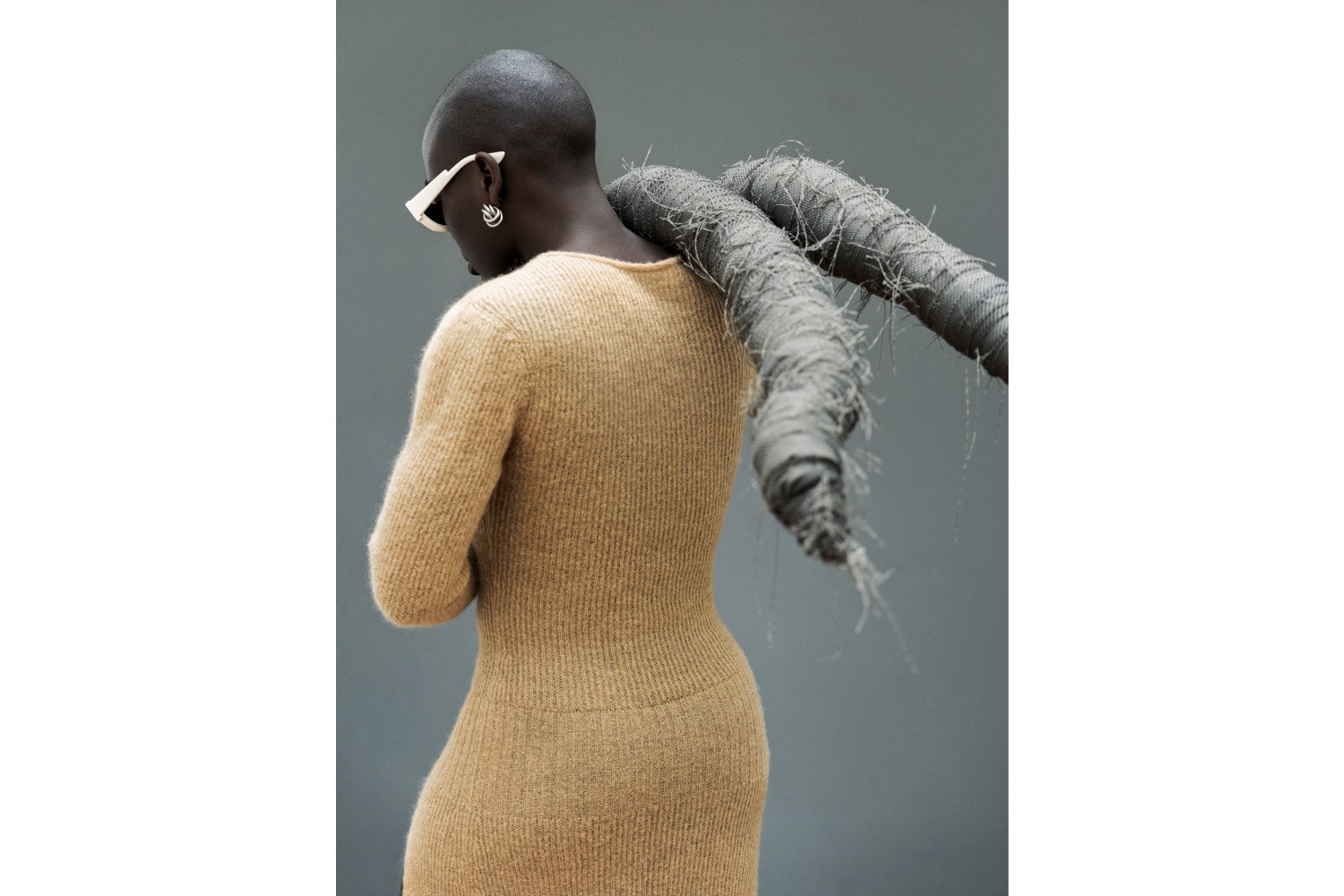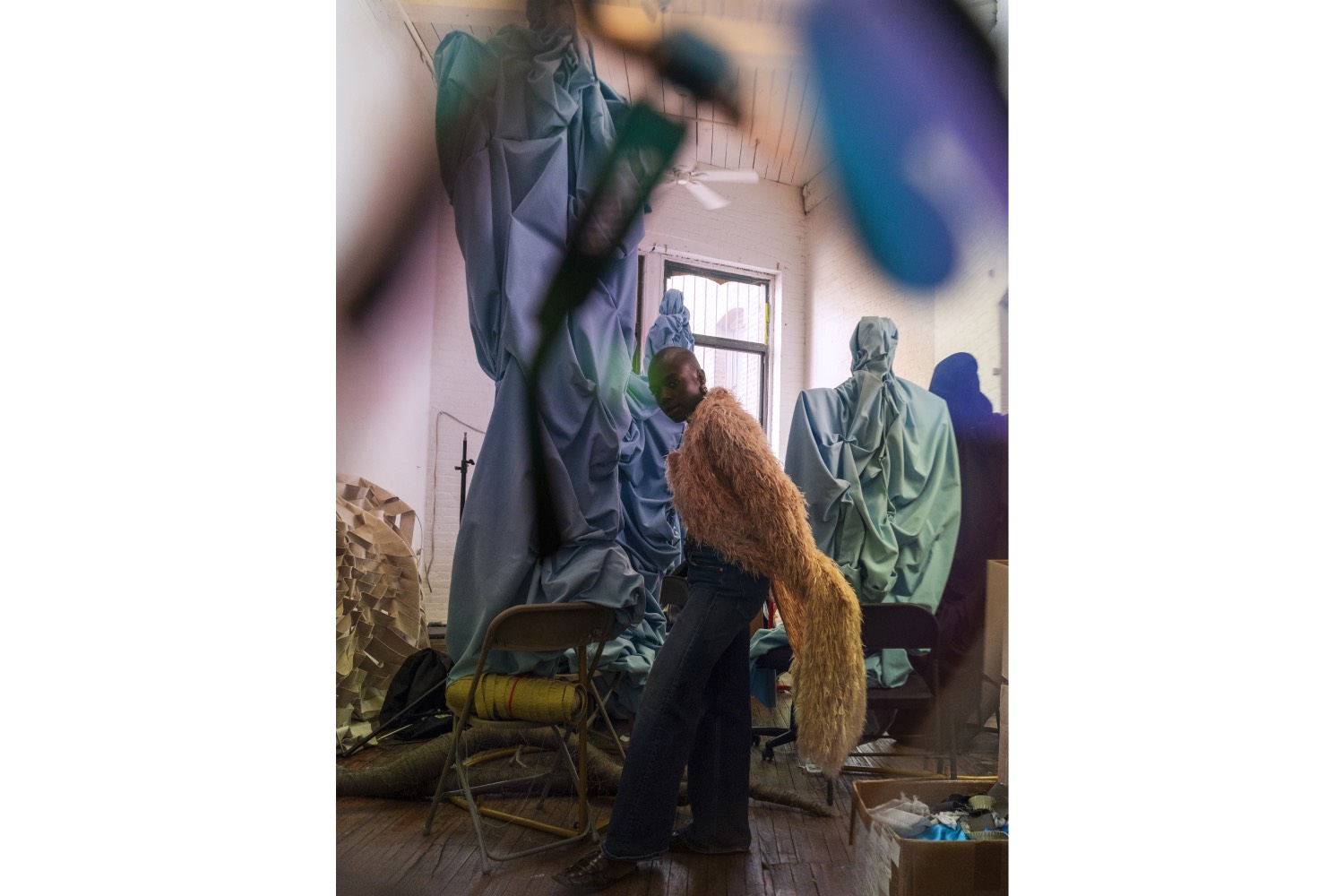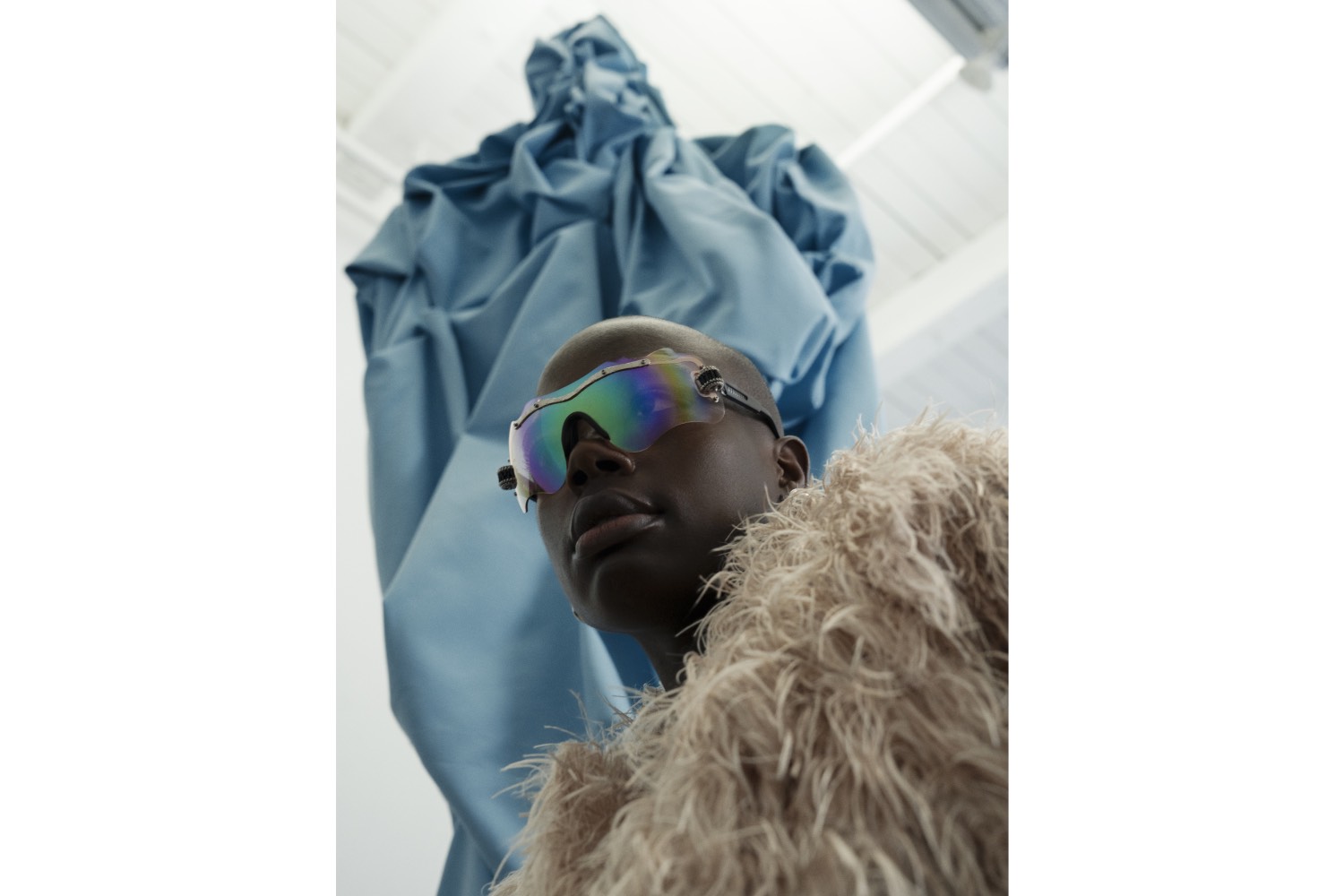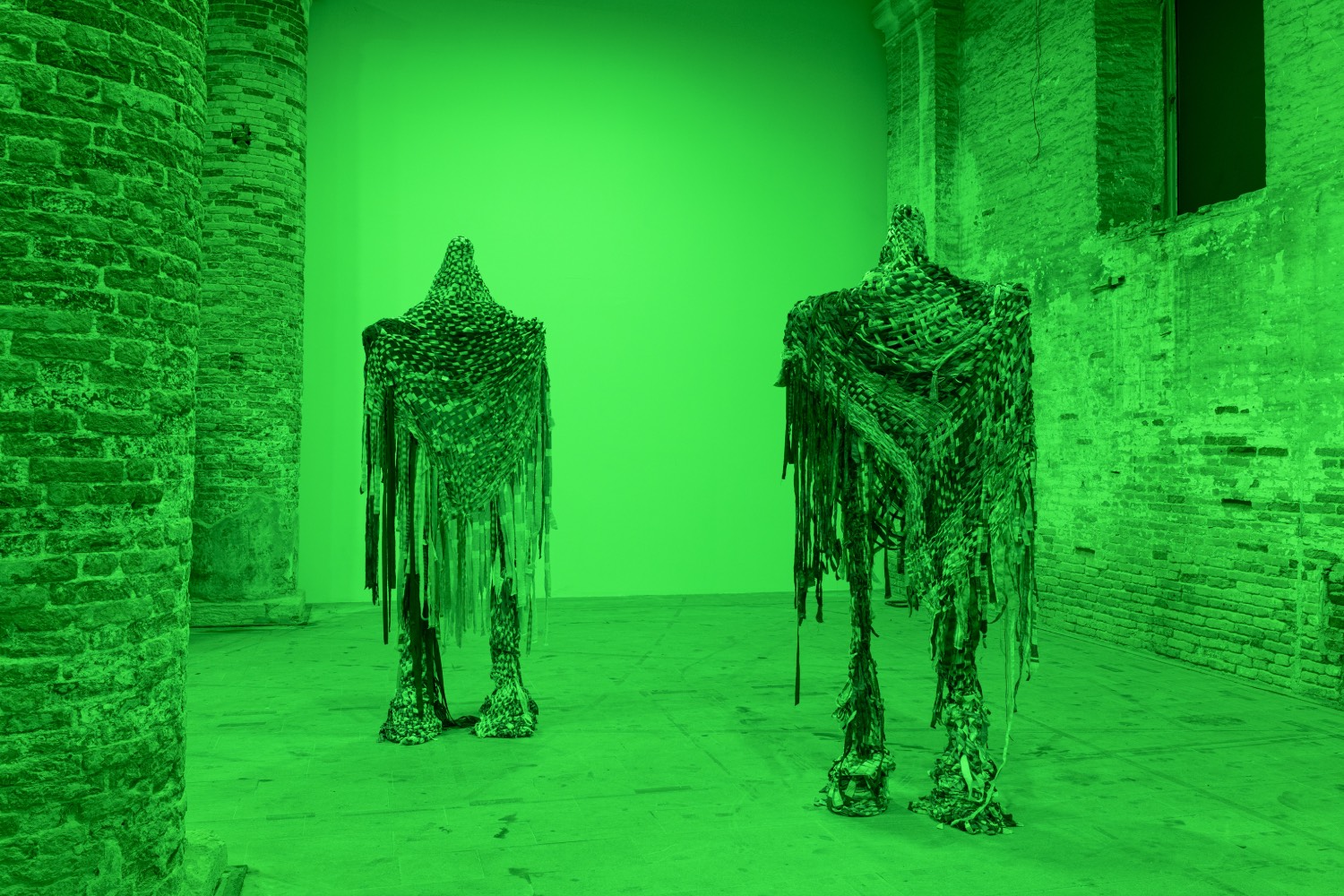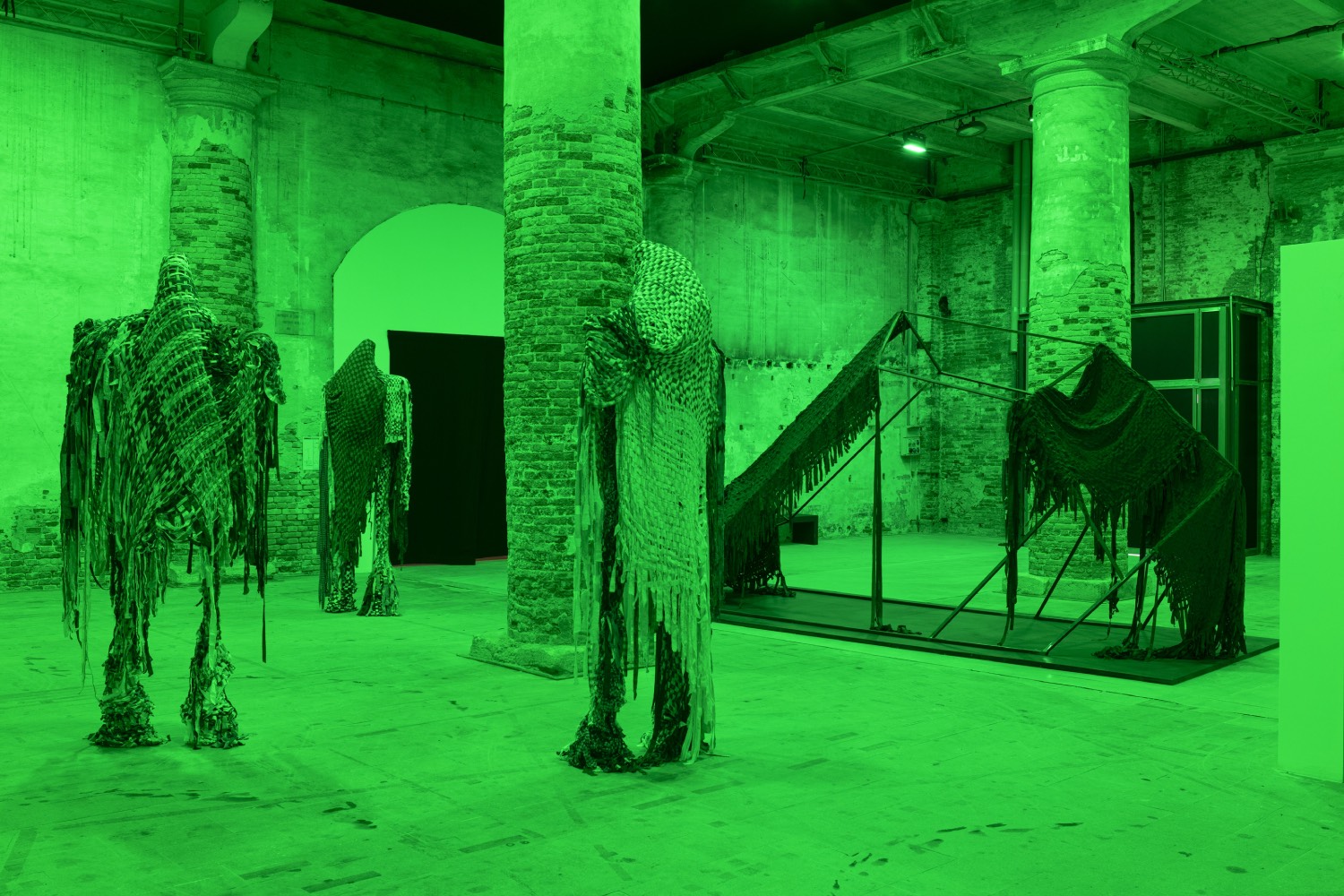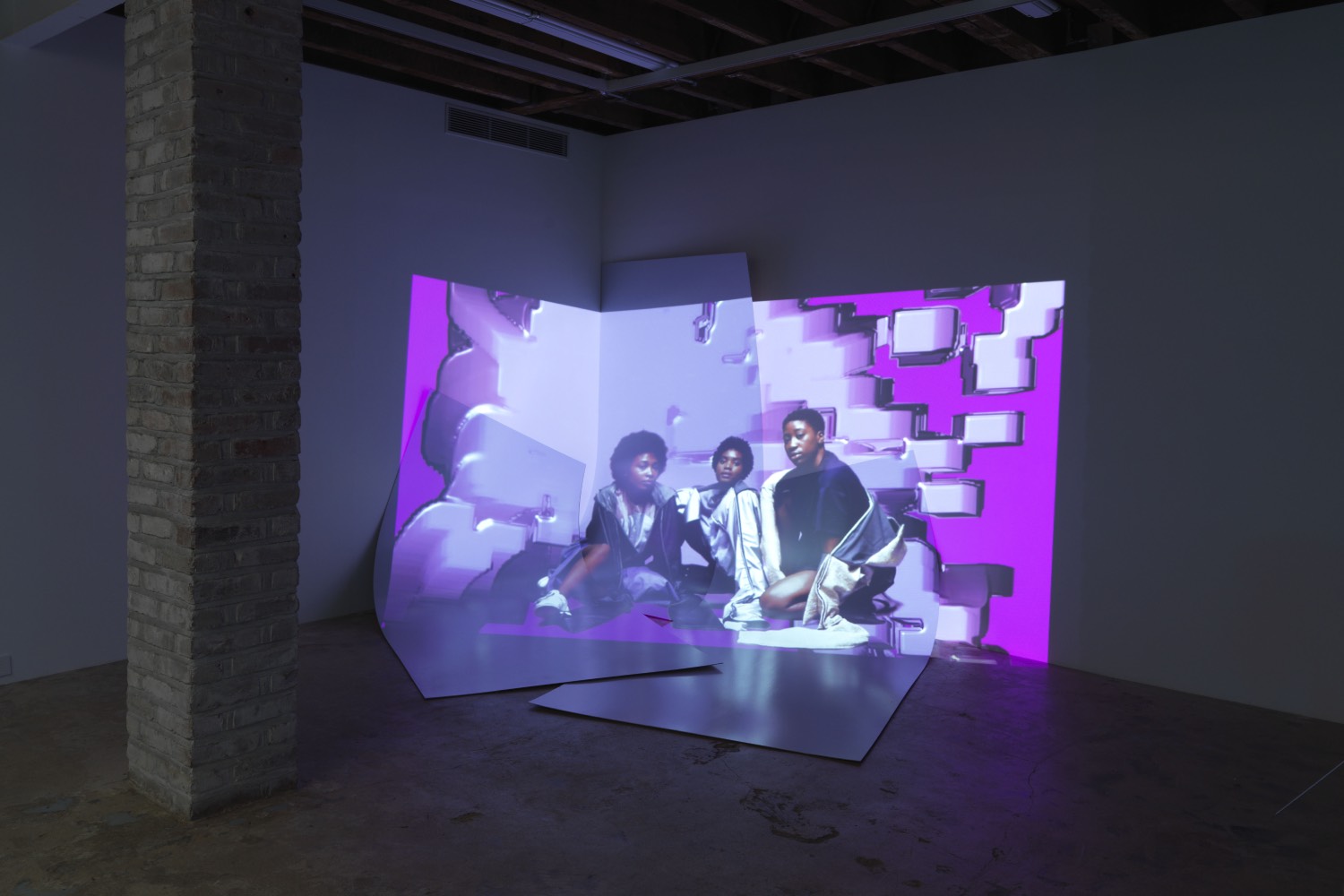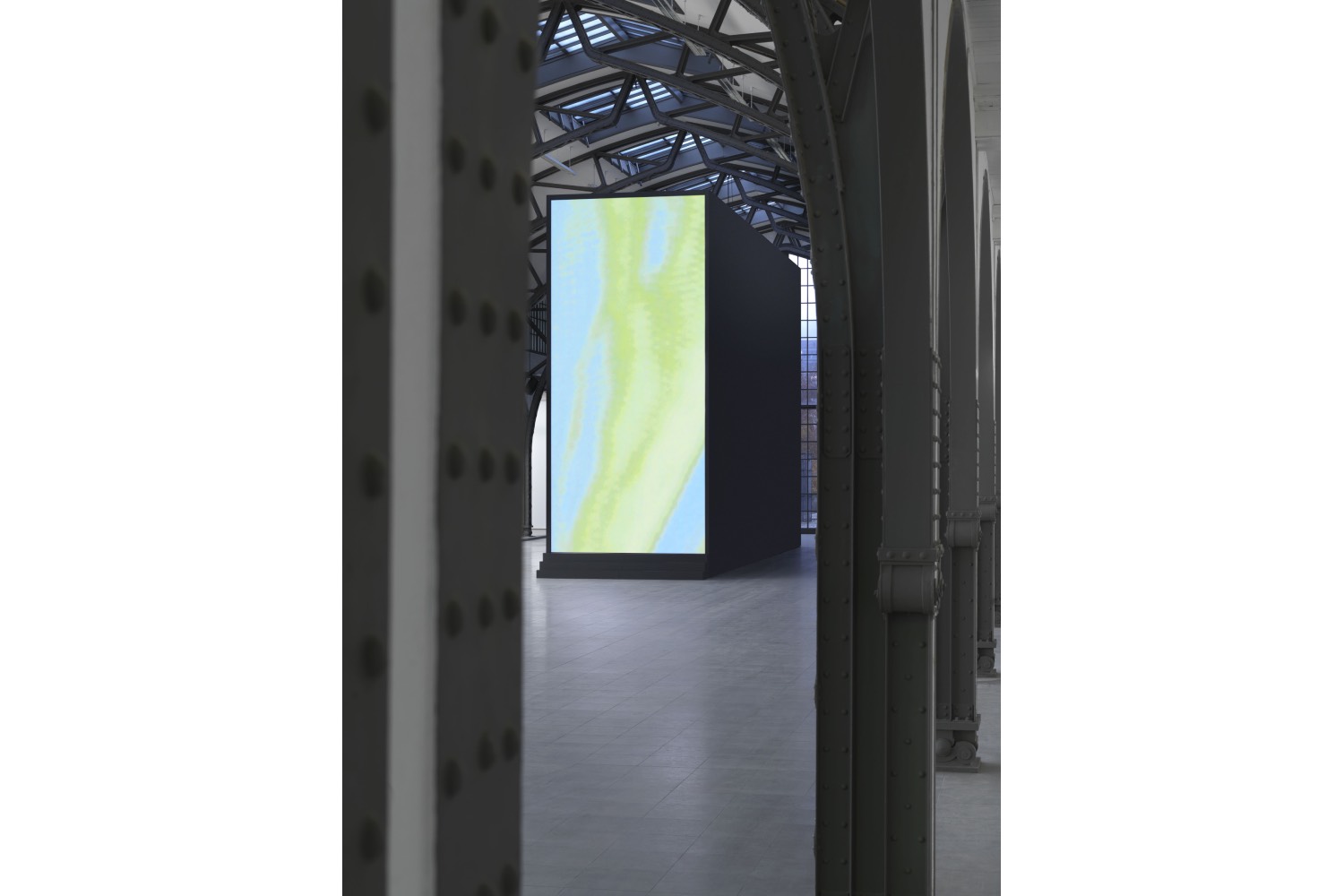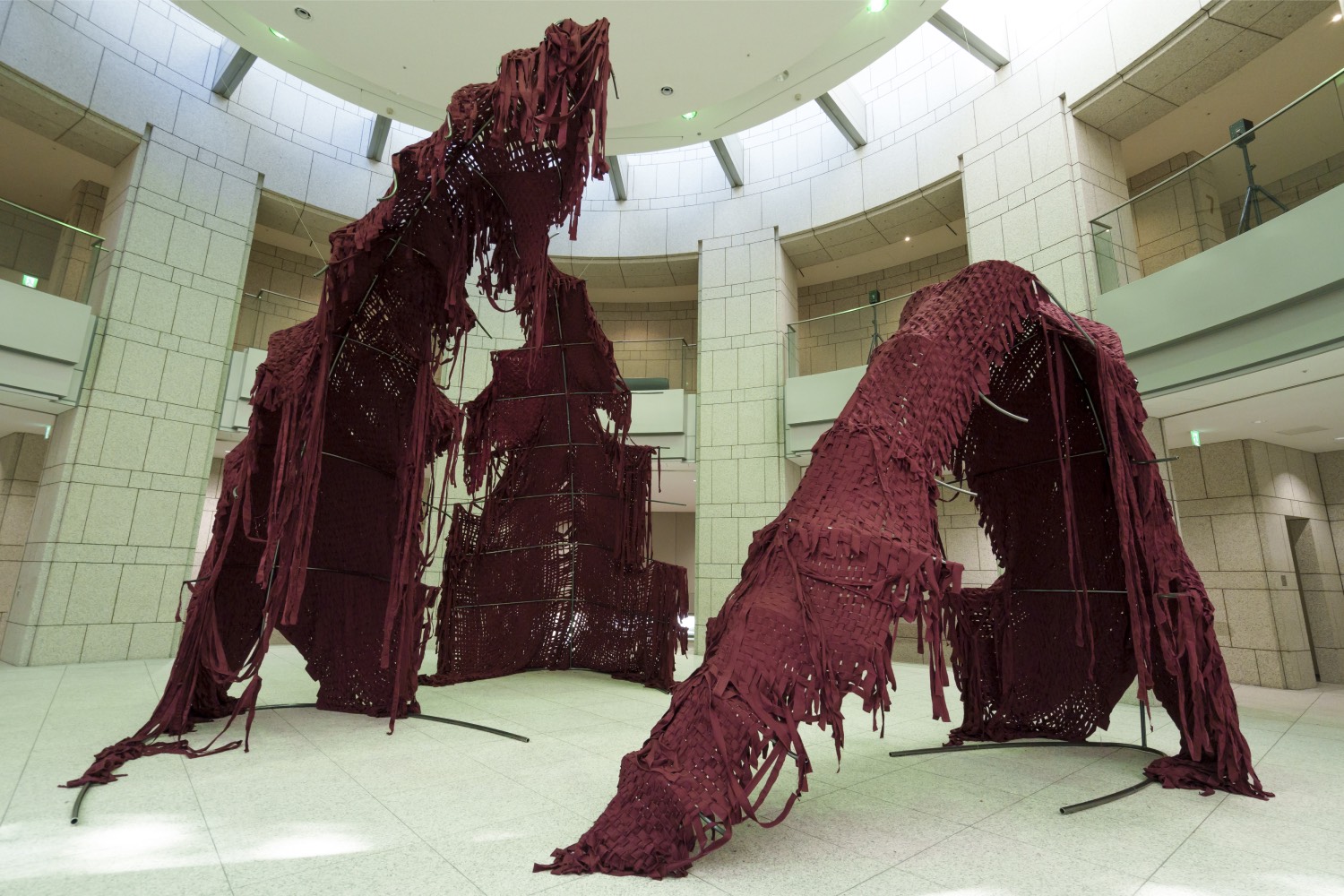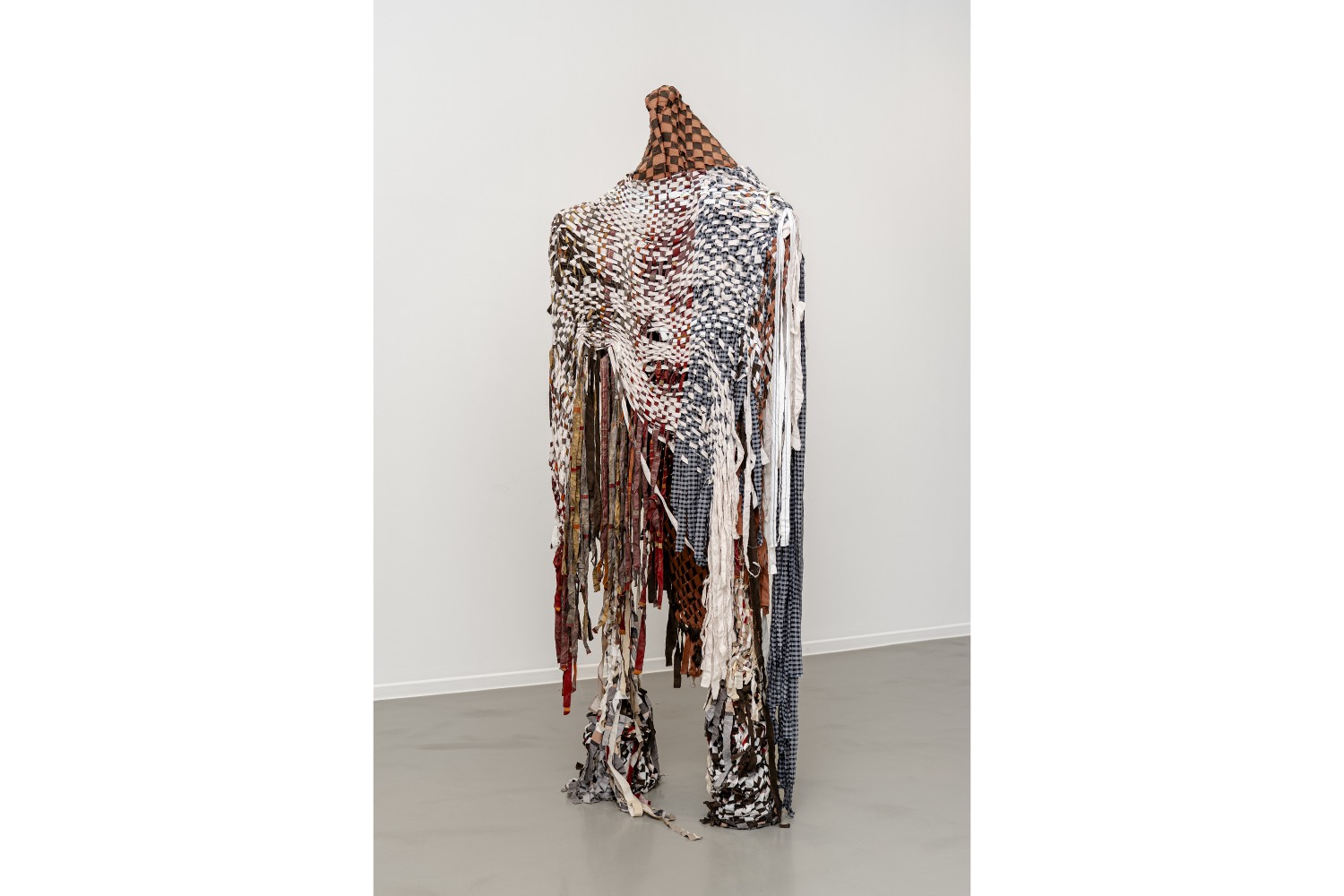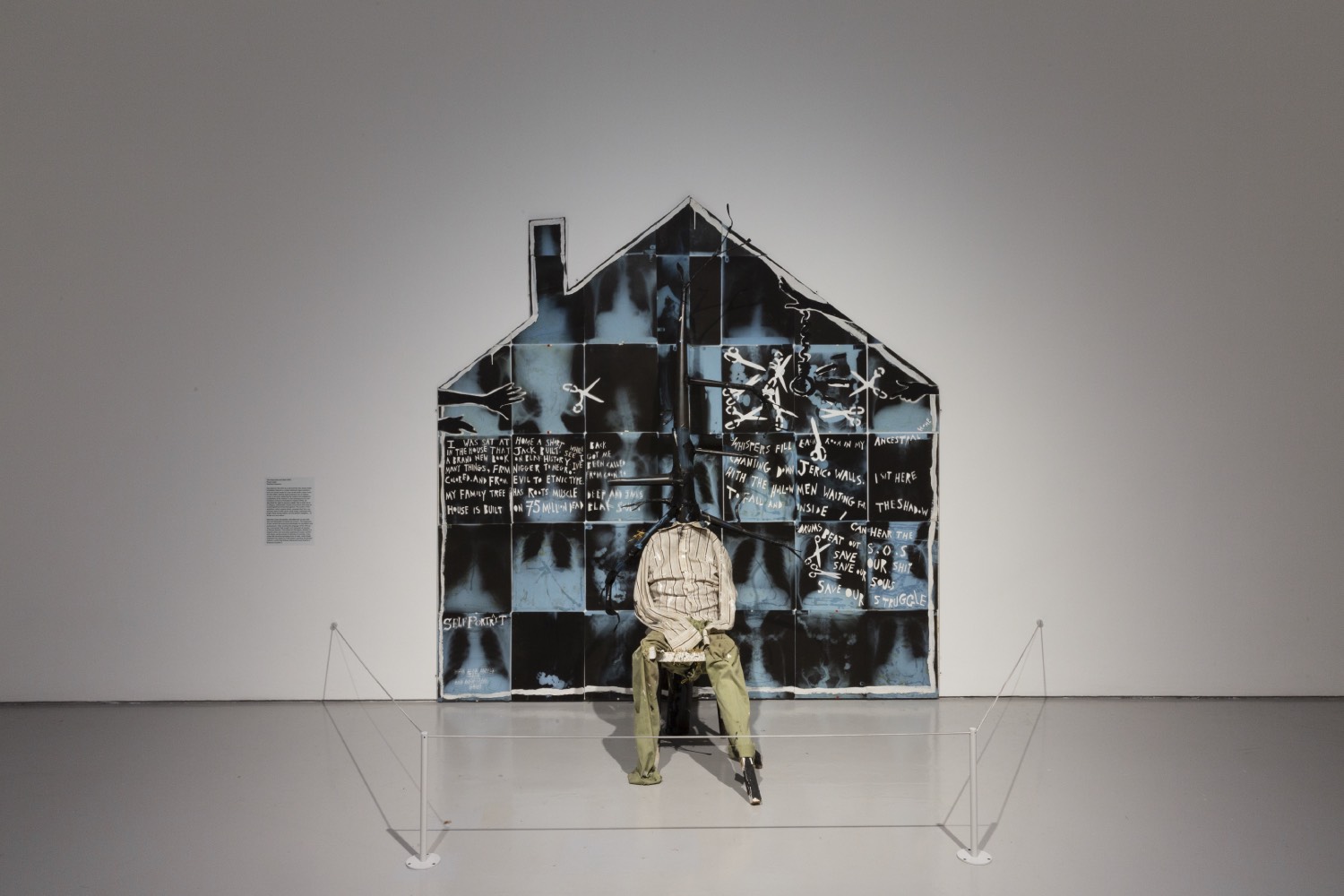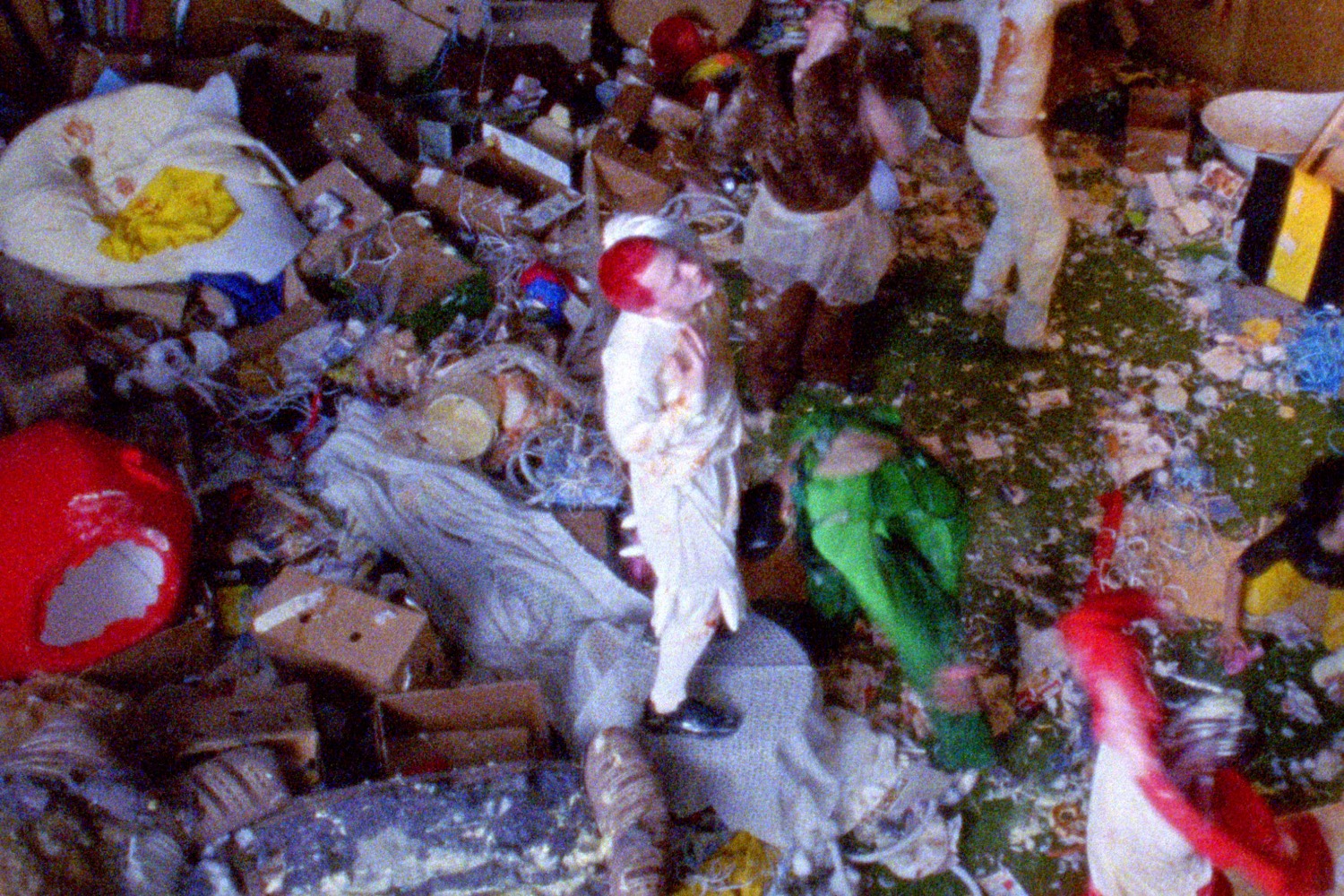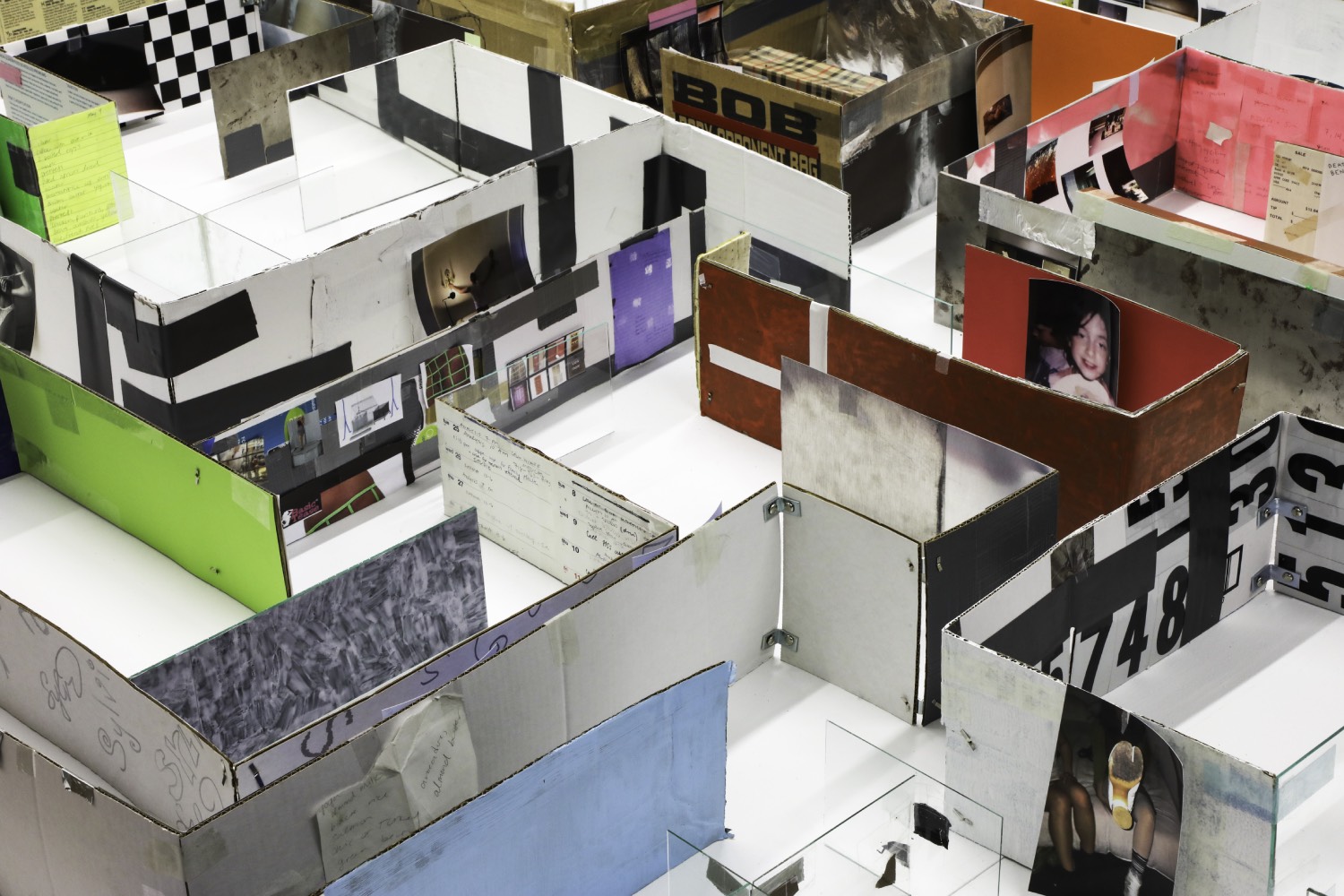Time as a passage. History as landscaping. Society as malaise. Bodies as construction sites. Language as technology. Nature as not yet.
Faced with Sandra Mujinga’s Sentinels of Change (2021), one may dwell on the dormant drives igniting her larger-than-life vessels, waiting to contest some unfathomable force. Are they warriors, robots of sorts, rebels, or mercenaries? Are they humans in disguise, or is disguise a humanoid feature? Are they there to look after us humans, or, conversely, to defeat humankind?
Since confronting those creatures at the 59th Venice Biennale for the first time, I couldn’t rid myself of their haunting presence — their stark existence trapped in the meanders of my mind, feeding the sense of paranoia that lingers above our so-called reality.
In their constitution, those sentinels, threaded in shreds of fabric, bathed in green light, evoke a rather distinctive otherworldly atmosphere, a sort of organic technology far from the usual sci-fi-esque features of glossy warriors on the silver screen. Conversely, though, they could conjure up traits of a remote civilization from another solar system, as depicted in the Star Wars saga. And in this sense, going even further in the Hollywoodian colonial analogy, could they be the incarnation of an animistic ritual of sorts?
If, on the one hand, those creatures belong to the Western imaginary of war and surveillance, on the other, they could very well be the embodiments of another cosmology, aside from the Eurocentric nature/culture divide.
Mujinga’s shapeshifting, metastatic body of work prompts its audience to see and feel through the membrane that persists in setting humans aside from what the Occident deems to be “nature” — transformative agencies never fully apprehensible and yet dismissed as a scientifically controlled ecology. One might even ponder if such a veil only exists to preserve modern epistemology as the fraught tale that it is: relentlessly told without any deviation from its master narrative.
Mujinga’s shapeshifting, metastatic body of work prompts its audience to see and feel through the membrane that persists in setting humans aside from what the Occident deems to be
“nature” — transformative agencies never fully apprehensible and yet dismissed as a scientifically controlled ecology. One might even ponder if such a veil only exists to preserve modern epistemology as the fraught tale that it is: relentlessly told without any deviation from its master narrative.
Sandra Mujinga is a Norwegian artist born in 1989 in Goma. D. R. Congo. She migrated to Norway with her mother, as a child, only occasionally returning to her native country to visit family and friends — in 2016, though, the artist would travel there to produce the exhibition “Real Friends”. Since her mother used to work in fashion, she was taught how to sew at a very early age, something that would later translate into her penchant for sculptural garments. And I only highlight such biographical notes as they appear to have
indelibly shaped the artist’s material practice and continue to inform the narratives she’s been weaving throughout a multifarious yet cohesive body of work. Mujinga’s country of birth remained a battleground for more than a hundred years — from King Leopold of Belgium’s occupation in 1885 to Congo’s turbulent independence in 1960, later enduring
more than thirty years of dictatorship under Mobuto’s rule, and not to mention the several civil wars that ravaged the country. The economic and political struggles of its native Black population are widely recognized as some of the most atrocious ordeals exerted by colonial regimes in modern history. And, since it cannot be otherwise with experiences of social and racial violence, the body remains the primary carrier of such burdens, the skin being the most evident signifier of economic and political hierarchies — what Frantz Fanon calls the epidermalization of conflict.
Mujinga’s videos, sculptures, performances, and installations convey a profound sense of intimacy with the body, the skin being the most susceptible surface where transformation can be felt and may indeed occur: the body — chimeric, human, or otherwise — becomes less a traumatic vessel than a site for forceful regeneration. Thus the mutant figures dissolving on screen to acquire virtual shapes (Disruptive Pattern, 2018); the abstract embodiments of flying dinosaurs threaded into organic fabric at the 2024 Yokohama Triennial; or the massive black portal through which the public eye can have a glimpse of quasi metamorphic corporal mutations occurring in a parallel dimension that intrudes upon our own (I build my skin with rocks, 2022). In Mujinga’s work, the present time is inexorably flanked by myriad space-time realities, regardless of the West’s teleological and linear historical renditions.
Moreover, the ever-present body is a central element within scenarios that often do not reveal themselves altogether, as in the case of Worldview (2021), the video installation presented at the Swiss Institute in New York, where both the human and the nonhuman insidiously appear to invest the “natural landscape” with an agency that goes beyond the human timeline — a glacial setting from which spectral images of monstrosities and humanoid creatures emerge and swiftly disappear amid a lake and its surrounding mountains. In this sense, the scenarios devised by the artist are less derivations of a sci-fi plot than they are manifestations of a never fully apprehended reality. Alternatively, her works could well be seen as allegories of a pluri-dimensional world, in which narratives either prosper or die under the dome of a supposedly unanimous Western landscape — or despite this very landscape.
The alien aura emanating from Mujinga’s subjects and settings demands a rather haptic, sensual, and phenomenological response from the public. Once immersed in her worldings, the perception of otherness provokes a rare notion of inverted power relations: for a fleeting moment, we, the spectators, become the estranged, the alien bodies, as a result of a pervasive atmosphere of uncertainty making us all succumb to unknown realms of life. However, since nature is not an enclosed category for Mujinga, material culture, technology, and even architecture might become living entities and assume features that transgress the idea of animality as opposed to notions of artificiality — material culture becoming an extension of life, or perhaps invested with a life of its own, like the prosthetic tails of Love Language (2023), sculptural ducts growing out of the walls.
Albeit magmatic, with epidermic eruptions bursting here and there, often in the guise of nonspecific virtual mutations or anomalies (Flo, 2019, for instance), not all Mujinga’s work is eminently image-based. Spoken language is also a constant element with which to deviate from fictional narratives into ordinary reality — and in this sense, the artist seems to be in a state of permanent political transition across Africa and Europe, equating her Congolese origins with the Norwegian gaze. As with the video Catching Up (2017), in which three black girlfriends lie together in front of an artificially green background while their offscreen voices keep saying, if not platitudes, righteous compliments about each other’s life and enduring struggles. Alternatively, in the video Throwing Voice (2016), a narrator repeats some sort of mantra about the glowing beauty of someone’s skin. Once again, we find ourselves before the ubiquity of the skin, both as the shell of a body and as a political category in itself.
Since Mujinga constantly uses chroma key1 effects, the characters in some of her works are often displaced and alienated in a setting where time and space are suspended. Thus, the atmosphere of paranoia in her narratives summons a reality that has been obliterated from our sight and memory — no matter how ostensibly real this despairing virtuality might appear.
On a different note, reality manifests itself quite bluntly in one of Mujinga’s videos shot in Congo. In He Who Was Shared (2016), we follow a man’s incursion into a jungle, captured from behind. The ranger cuts through the vegetation mercilessly until a gorilla is found in the tranquility of its natural habitat. The misleading apparent violence of the human delving into the forest is contrasted with the animal’s peaceful sovereign presence — one that nonetheless evokes human traits, thus confronting us with our own sheer human animality.
But, by far, the most peculiar of her works is the very first in her portfolio: My Uncle, featuring Ben Affleck, George Clooney, and Robin Wright (2015). In a series of photographs, as per its title, Mujinga’s uncle appears next to Hollywood movie stars. Besides the apparent mere coincidence of such encounters, this work perhaps amounts to a seminal index of the artist’s fascination with the world of fiction — a terrain that is at once revelatory and concealing of the stratification of Western civilizations on economic, social, and imaginative grounds. Film stars as the epitome of propaganda, pervasive iconographies within non-hegemonic cultures, limiting the realm of fiction to WASP narratives of power and supremacy — or to Manichean visions of good and evil, right and wrong, nature and culture.
“You are horror and beauty in rare combination.”2
– Octavia Butler
If, on the one hand, Mujinga’s work explores layers of speculative fiction and indeed revolves around Blackness as both a concept (the lack of light) and a skin color marked by a history of colonialism, on the other, it seldom depicts a utopian future or a future of emancipation, as many Afrofuturists would be inclined to do. Since the fantasies embedded in her work appear rather somber, they could also be perceived as the inverse of that “genre,” i.e., Afro-pessimism, a concept briefly entertained by the artist in our conversation. Yet the latter — as depicted in Frank B. Wilderson’s eponymous book from 2020 — wouldn’t quite encapsulate the ideas behind her art, as she doesn’t stretch them to the point of either articulating a solemn libel against notions of contemporary enslavement or pronouncing a sheer nihilism toward the future, however gloomy her scenarios might appear. Therefore, I’d risk saying the artist’s works are about the unknown, the unacknowledged, or what has yet to come — a liminal sphere in which shadows aggravate the lack of clarity both in our immediate and most distant horizons.
Sandra Mujinga’s body of work expands through a gamut of impressions and emotions that allow us to experience both presence and absence, fear and wonder, without the need to incur blunt dichotomies or clarifying ambivalences of inner and outer worlds. For that matter, neither reality nor fantasy, neither angels nor monsters, neither the past nor the future; instead, a lugubrious, oozy atmosphere of unstable visual tropes. Either sensorially or allegorically, Mujinga’s works allow us to wobble in the darkness of extended visual narratives. Under a shadow of constant doubt, we drag the shreds of our imagination toward what has yet to acquire shape: sliding depictions of what remains to be grasped of overlapping worlds within unknown realms of existence.
“Nature does not yet exist!”3

